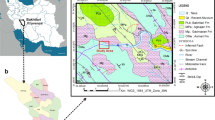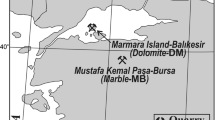Abstract
The compression index (Cc) is a necessary parameter for the settlement calculation of clays. However, determination of the compression index from oedometer tests takes a relatively long time and leads to a very demanding experimental working program in the laboratory. Therefore, geotechnical engineering literature involves many studies based on indirect methods such as multiple regression analysis (MLR) and soft computing methods to determine the compression index. This study is aimed to predict the compression index by using extreme learning machine (ELM), Bayesian regularization neural network (BRNN), and support vector machine (SVM) methods. The selected variables for each method are the natural water content (wn), initial void ratio (e0), liquid limit (LL), and plasticity index (PI) of clay samples. Many trials were carried out in order to get the best prediction performance with each model. The application results obtained from the models were also compared based on the correlation coefficient (R), coefficient of efficiency (E), and mean squared error (MSE). The results indicate that the BRNN method has better success on estimation of the compression index compared to the ELM and SVM methods.











Similar content being viewed by others
References
Abasi HM, Shooshpasha I, Ebrahimi A (2016) Prediction of the compression index of saturated clays (Cc) using polynomial models. Scientia Iran 23(2):500–507
Abdalla JA, Attom MF, Hawileh R (2015) Prediction of minimum factor of safety against slope failure in clayey soils using artificial neural network. Environ Earth Sci 73(9):5463–5477
Azzous AS, Krizek RJ, Corotis RB (1976) Regression Analysis of Soil Compressibility. Soils Found 16(2):19–29
Balbay A, Kaya Y, Sahin O (2012) Drying of black cumin (Nigella sativa) in a microwave assisted drying system and modeling using extreme learning machine. Energy, Elsevier 44(1):352–357
Bowles JE (1989) Physical and geotechnical properties of soils. McGraw-Hill Book Company, New York
Bui DT, Pradhan B, Lofman O, Revhaug I, Dick OB (2012) Landslide susceptibility assessment in the Hoa Binh province of Vietnam: a comparison of the Levenberg–Marquardt and Bayesian regularized neural networks. Geomorphology 171:12–29. https://doi.org/10.1016/j.geomorph.2012.04.023
Burden F, Winkler D (2008) Bayesian regularization of neural networks. In: Livingstone DJ (ed) Artificial neural network: method and application. Humana Press, Totowa, pp 25–44
Caballero J, Fernández M (2006) Linear and nonlinear modeling of antifungal activity of some heterocyclic ring derivatives using multiple linear regression and Bayesian-regularized neural networks. J Mol Model 12(2):168–181
Chik Z, Aljanabi QA, Kasa A, Taha MR (2014) Tenfold cross validation artificial neural network modeling of the settlement behavior of a stone column under a highway embankment. Arab J Geosci 7(11):4877–4887. https://doi.org/10.1007/s12517-013-1128-6
Cortes C, Vapnik V (1995) Support vector networks. Mach Learn 20(3):273–297
Cozzolino VM (1961) Statistical Forecasting of Compression Index, Proc. of the 5th Int. Conf. on Soil Mechanics and Foundation Engineering, Paris, 1, pp 51–53
Cristianini N, Shaw-Taylor J (2000) An introduction to support vector machines and other kernel based learning methods. Cambridge University Press, Cambridge
Das SK, Biswal RK, Sivakugan N, Das B (2011) Classification of slopes and prediction of fact or of safety using differential evolution neural networks. Environ Earth Sci 64(1):201–210
Demir A (2015) New computational network models for better predictions of the soil compression index. Acta Geotech Slov 12(1):59–69
Dibike YB, Velikov S, Solomatine D, Abbott MB (2001) Model induction with support vector machines: introduction and applications. J Comput Civ Eng ASCE 15(3):208–216
Dipova N, Cangir B (2010) Determination of Compaction Properties of Clay-Silt Soils by Regression and Artificial Neural Networks. Tech J 332(1):5069–5086
Feizizadeh B, Roodposhti MS, Blaschke T, Aryal J (2017) Comparing GIS-based support vector machine kernel functions for landslide susceptibility mapping. Arab J Geosci 10(122). https://doi.org/10.1007/s12517-017-2918-z
Fletcher R (2000) Practical methods of optimization, 2nd edn. Wiley, New York
Hai-Jun R, Yew-Soon O, Ah-Hwee T, Zhu Z (2008) A fast pruned-extreme learning machine for classification problem. Neurocomputing 72:359–366
Haykin S (1994) Neural networks: a comprehensive foundation. MacMillan, New York
Herrero OR (1983) Universal compression index equation; Closure. J Geotech Eng ASCE 109(5):755–761
Hirschen K, Schäfer M (2006) Bayesian regularization neural networks for optimizing fluid flow processes. Comput Methods Appl Mech Eng 195(7–8):481–500. https://doi.org/10.1016/j.cma.2005.01.015
Holtz RD, Kovacs WD (1981) An introduction to geotechnical engineering. Prentice-Hall, Inc., Englewood Cliffs 733pp
Hough BK (1957) Basic Soils Engineering. The Ronald Press Company, New York, pp 114–115
Huang GB, Zhu QY, Siew CK (2006) Extreme learning machine: theory and applications. Neurocomputing 70:489e501
Huang F, Huang J, Jiang S, Zhou C (2017a) Landslide displacement prediction based on multivariate chaotic model and extreme learning machine. Eng Geol 218:173–186
Huang F, Yin K, Huang J, Gui L, Wang P (2017b) Landslide susceptibility mapping based on self-organizing-map network and extreme learning machine. Eng Geol 223:11–22
Jalalifara H, Mojedifar S, Sahebi AA, Nezamabadi-pour H (2011) Application of the adaptive neuro-fuzzy inference system for prediction of a rock engineering classification system. Comput Geotech 38(6):783–790. https://doi.org/10.1016/j.compgeo.2011.04.005
Kalantary F, Kordnaeij A (2012) Prediction of compression index using artificial neural network. Sci Res Essays 7(31):2835–2848. https://doi.org/10.5897/SRE12.297
Kaya Y, Kayci L, Tekin R, Ertuğrul ÖM (2014) Evaluation of texture features for automatic detecting butterfly species using extreme learning machine. J of Experimental & Theoretical Artificial Intell 26(2():267–281
Kohestani VR, Hassanlourad M (2016) Modeling the mechanical behavior of carbonate sands using artificial neural networks and support vector machines. Int J of Geomechanics 16(1). https://doi.org/10.1061/(ASCE)GM.1943-5622.0000509
Koppula SD (1981) Statistical estimation of compression index. Geotech Test J 4(2):68–73
Kordjazi A, Nejad FP, Jaksa MB (2014) Prediction of ultimate axial load-carrying capacity of piles using a support vector machine based on CPT data. Comput Geotech 55:91–102. https://doi.org/10.1016/j.compgeo.2013.08.001
Levasseur S, Malecot Y, Boulon M, Flavigny E (2008) Soil parameter identification using a genetic algorithm. Int J Numer Anal Methods Geomech 32:189–213. https://doi.org/10.1002/nag.614
Li W, Mei S, Zai S, Zhao S, Liang X (2006) Fuzzy models for analysis of rock mass displacements due to underground mining in mountainous areas. Int J Rock Mech Min Sci 43(4):503–511. https://doi.org/10.1016/j.ijrmms.2005.09.008
Li AJ, Khoo S, Lyamin AV, Wang Y (2016) Rock slope stability analyses using extreme learning neural network and terminal steepest descent algorithm. Autom Constr 65:42–50
Liu Z, Shao J, Xu W, Chen H, Zhang Y (2014) An extreme learning machine approach for slope stability evaluation and prediction. Nat Hazards 73(2):787–804
Liu Z, Shao J, Xu W, Wu Q (2015) Indirect estimation of unconfined compressive strength of carbonate rocks using extreme learning machine. Acta Geotech 10(5):651–663
MacKay DJC (1991) Bayesian methods for adaptive models. Ph.D. thesis, California Institute of Technology
McCombie P, Wilkinson P (2002) The use of the simple genetic algorithm in finding the critical factor of safety in slope stability analysis. Comput Geotech 29(8):699–714. https://doi.org/10.1016/S0266-352X(02)00027-7
Muduli PK, Das SK, Das MJ (2013) Prediction of lateral load capacity of piles using extreme learning machine. Int J Geotech Eng 7(4):388–394
Muduli PK, Das SK, Samui P, Sahoo R (2015) Prediction of uplift capacity of suction caisson in clay using extreme learning machine. Ocean Sys Eng An Int J 5(1):41–54. https://doi.org/10.12989/ose.2015.5.1.041
Nacci VA, Wang MC, Demars KR (1975) Engineering behavior of calcareous soils. In: Proceedings of Civil Engineering in the Oceans III, ASCE Specialty Conference, Newark, Del., 9– 12 June 1975, vol 1. American Society of Civil Engineers, New York, pp 380–400
Nagaraj TS, Murthy BRS (1985) A critical reappraisal of compression index equations. Geotechnique 36(1):27–32
Namdarvand F, Jafarnejadi A, Sayyad G (2013) Estimation of soil compression coefficient using artificial neural network and multiple regressions. Int Research J of App and Basic Sci 4(10):3232–3236
Nejad FP, Jaksa MB, Kakhi M, McCabe BA (2009) Prediction of pile settlement using artificial neural networks based on standard penetration test data. Comput Geotech 36(7):1125–1133
Nishida Y (1956) A brief note on compression index of soil. J Soil Mech Found Eng ASCE 82(3):1–14
Oh HJ, Pradhan B (2011) Application of a neuro-fuzzy model to landslide-susceptibility mapping for shallow landslides in a tropical hilly area. Comput Geosci 37(9):1264–1276. https://doi.org/10.1016/j.cageo.2010.10.012
Okut H (2016) Bayesian regularized neural networks for small n big p Data. In Artificial neural networks-models and applications. InTech
Padmini D, Ilamparuthi K, Sudheer KP (2008) Ultimate bearing capacity prediction of shallow foundations on cohesionless soils using neurofuzzy models. Comput Geotech 35(1):33–46. https://doi.org/10.1016/j.compgeo.2007.03.001
Park HI, Lee SR (2011) Evaluation of the compression index of soils using an artificial neural network. Comput Geotech 38(4):472–481. https://doi.org/10.1016/j.compgeo.2011.02.011
Saboya F, Alves MG, Pinto WD (2006) Assessment of failure susceptibility of soil slopes using fuzzy logic. Eng Geol 86(4):211–224. https://doi.org/10.1016/j.enggeo.2006.05.001
Samui P (2008) Support vector machine applied to settlement of shallow foundations on cohesionless soils. Comput Geotech 35(3):419–427. https://doi.org/10.1016/j.compgeo.2007.06.014
Samui P, Kothari DP (2011) Utilization of a least square support vector machine (LSSVM) for slope stability analysis. Scientia Iran 18(1):53–58. https://doi.org/10.1016/j.scient.2011.03.007
Samui P, Sitharam TG, Kurup PU (2008) OCR prediction using support vector machine based on piezocone data. J Geotech Geoenviron Eng ASCE 134(6):894–898. https://doi.org/10.1061/(ASCE)1090-0241(2008)134:6(894)
Shouka H (1964) Relationship of compression index and liquid limit of alluvial clay. In: Proceedings of the 19th Japan Civil Engineering Conference, Touhoku. vol. 4, pp. 40.1–40.2
Skempton AW (1944) Notes on the Compressibility of Clays. Q J Geol Soc Lond 100:119–135
Smola AJ, Schölkopf B (1998) A tutorial on support vector regression. Rep No. NC2-TR-1998-030. NeuroCOLT2 Tech Rep Ser
Song O, Hu W, Xie W (2002) Robust support vector machine with bullet hole image classification. IEEE Trans Syst Man Cybern Part C Appl Rev 32(4):440–448
Sowers GB (1970) Introductory soil mechanics and foundations, 3rd edn. The Macmillan Company, London
Sulewska MJ (2011) Applying artificial neural networks for analysis of geotechnical problems. Comput Assist Mech Eng Sci 18:231–241
Sun Z, Chen Y, Li X, Qin X, Wang H (2017) A Bayesian regularized artificial neural network for adaptive optics forecasting. Opt Commun 382:519–527
Suresh S, Saraswathi S, Sundararajan N (2010) Performance enhancement of extreme learning machine for multi-category sparse data classification problems. Eng Appl Artif Intell 23:1149–1157
Terzaghi K, Peck RB (1967) Soil mechanics in engineering practice. Wiley, Hoboken
Xue X, Xiao M (2016) Application of genetic algorithm-based support vector machines for prediction of soil liquefaction. Environ Earth Sci 75(874). https://doi.org/10.1007/s12665-016-5673-7
Yoon GL, Kim BT, Jeon SS (2004) Empirical correlations of compression index for marine clay from regression analysis. Can Geotech J 41:1213–1221
Author information
Authors and Affiliations
Corresponding author
Rights and permissions
About this article
Cite this article
Fikret Kurnaz, T., Kaya, Y. The comparison of the performance of ELM, BRNN, and SVM methods for the prediction of compression index of clays. Arab J Geosci 11, 770 (2018). https://doi.org/10.1007/s12517-018-4143-9
Received:
Accepted:
Published:
DOI: https://doi.org/10.1007/s12517-018-4143-9




